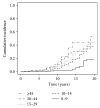Influence of Age at Diagnosis and Time-Dependent Risk Factors on the Development of Diabetic Retinopathy in Patients with Type 1 Diabetes
- PMID: 27213158
- PMCID: PMC4861784
- DOI: 10.1155/2016/9898309
Influence of Age at Diagnosis and Time-Dependent Risk Factors on the Development of Diabetic Retinopathy in Patients with Type 1 Diabetes
Abstract
Aim. To determine the influence of age at onset of type 1 diabetes and of traditional vascular risk factors on the development of diabetic retinopathy, in a cohort of patients who have been followed up after onset. Methods. Observational, retrospective study. The cohort consists of 989 patients who were followed up after diagnosis for a mean of 10.1 (SD: 6.8) years. The influence of age at diagnosis, glycemic control, duration of diabetes, sex, blood pressure, lipids, BMI, and smoking is analyzed using Cox univariate and multivariate models with fixed and time-dependent variables. Results. 135 patients (13.7%) developed diabetic retinopathy. The cumulative incidence was 0.7, 5.9, and 21.8% at 5-, 10-, and 15-year follow-up, respectively. Compared to the group with onset at age <10 years, the risk of retinopathy increased 2.5-, 3-, 3.3-, and 3.7-fold in the groups with onset at 10-14, 15-29, 30-44, and >44 years, respectively. During follow-up we also observed an association between diabetic retinopathy and HbA1c levels, HDL-cholesterol, and diastolic blood pressure. Conclusion. The rate of diabetic retinopathy is higher in patients who were older at type 1 diabetes diagnosis. In addition, we confirmed the influence of glycemic control, HDL-cholesterol, and diastolic blood pressure on the occurrence of retinopathy.
Figures
References
-
- Henricsson M., Nyström L., Blohmé G., et al. The incidence of retinopathy 10 years after diagnosis in young adult people with diabetes: results from the nationwide population-based Diabetes Incidence Study in Sweden (DISS) Diabetes Care. 2003;26(2):349–354. doi: 10.2337/diacare.26.2.349. - DOI - PubMed
Publication types
MeSH terms
LinkOut - more resources
Full Text Sources
Other Literature Sources
Medical


